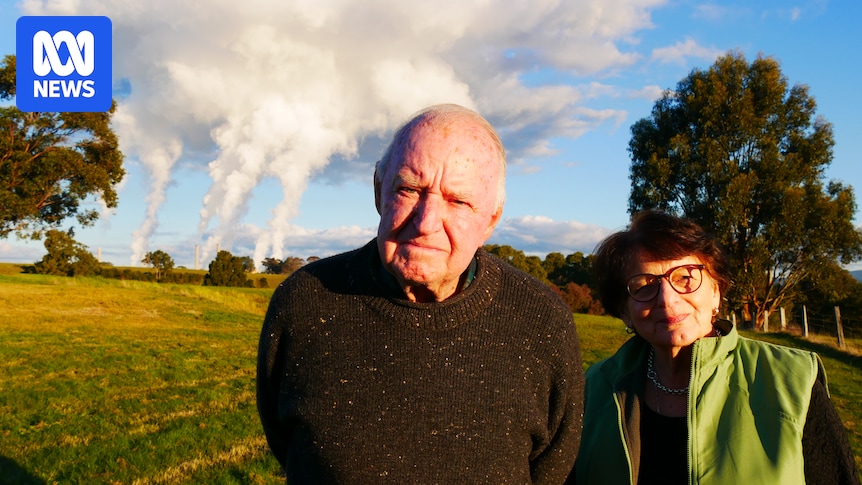Victorian businessman Jim Radford set up house just down the road from the Fukushima nuclear plant when he moved to Japan from his coal country hometown of Traralgon 21 years ago.
But having returned to the Latrobe Valley, he has been faced with the prospect of nuclear a lot closer to home.
And it excites him.
Mr Radford, who operates global companies from his office in Traralgon, said he was discussing Peter Dutton’s nuclear plan with enthusiasm.
Mr Radford supports nuclear power generation on his doorstep. (ABC News: Rachael Lucas)
“I’ve lived next door to nuclear reactors in Japan, I didn’t flinch at all,” Mr Radford said.
Mr Radford lived just down the road from Fukushima for two years before an earthquake and subsequent tsunami damaged a nuclear power plant in 2011.
Locals divided at first regional public hearing on nuclear power in central Queensland
Despite the disaster, he had confidence nuclear energy was a good prospect for the Latrobe Valley.
“It gets people a little nervous, but you’ve got all the state-of-the-art security around it,” he said.
He said far more information needed to be explained to communities.
“Considering nuclear power has been around for such a long time now, it’s a very mature industry,” Mr Radford said.
“There’s definitely more investigation needed … people are more informed now so you have to give them more information, don’t hold back on that.”
The federal parliament’s Inquiry into Nuclear Power Generation in Australia travelled to the Latrobe Valley on Tuesday to hear residents’ views about the prospect of having a nuclear in their backyard.
In its policy, the Coalition has identified the site of the Loy Yang A power station, situated outside the town of Traralgon, as one of seven coal sites where it would like to build nuclear plants.
The public hearing comes a day after the Australian Energy Market Operator (AEMO) announced it wanted emergency powers to switch off or throttle rooftop solar to cope with its output.
AEMO has warned that the share of total electricity demand being met by rooftop solar could be as high as 90 per cent at times.
It fears that solar output will pose an increasing threat to the security of the grid because it is pushing out other forms of generation that are required to keep the system stable.
Johanna and Barry Sykes are divided on the future of nuclear. (ABC News: Rachael Lucas)
Couple divided
The smoke stacks of a coal-fired power plant have always formed a backdrop to Barry and Johanna Sykes’s lives.
They’ve been married for 53 years, and they’re proud of the century of power generation their community has given Australia.
But with the prospect of a nuclear power plant within five kilometres of their Traralgon home, their views are divided.
“It’s quite interesting but we’re very respectful of each other’s opinions and it enhances the conversation,” Ms Sykes said.
Johanna and Barry Sykes disagree on the proposal for a nuclear plant near their home. (ABC News: Rachael Lucas)
Ms Sykes ran as a candidate in the 2016 council elections in a bid to advocate for the future of coal after travelling to her homeland of Holland and hearing 13 per cent of its energy came from Australia’s coal exports.
She said while she welcomed renewable energy, she believed nuclear power generation could open doors.
Johanna Sykes is supportive of a discussion about nuclear power in the Latrobe Valley. (ABC News: Bec Symons)
“It will bring work, it will bring education, it will bring innovation and also research into our area,” she said.
“We very much appreciate our solar and renewables to look after our planet but we might need something else to look after that base load.”
She said she expected her community’s vote at next year’s federal election would be influenced by the Coalition’s nuclear plan.
“I think it will be a main topic because it’s very important, the future of energy,” Ms Sykes said.
“You hope there’d be full security and there would be no problems involved.”
Barry Sykes says he prefers coal as a power source over nuclear. (ABC News: Bec Symons)
Mr Sykes, who is a mining historian, said he was proud of the legacy of power generation in the Latrobe Valley.
He said Australia would be far better off sticking with brown coal rather than dangle any prospect of nuclear development.
“It’s all very nice to say, ‘Oh yes, Loy Yang’s a power station, let’s put a nuclear power station instead’ but it’s not quite as simple as that,” Mr Sykes said.
“With nuclear power stations, as was shown with ones overseas, it doesn’t matter where the wind is blowing, they could be a real worry, apart from the cost.”
